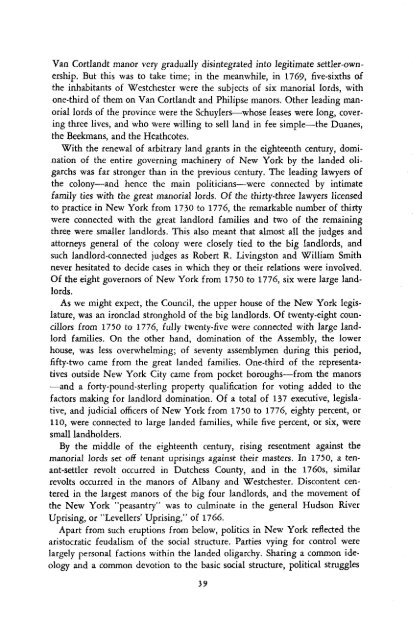Conceived in Liberty Volume 2 - Ludwig von Mises Institute
Conceived in Liberty Volume 2 - Ludwig von Mises Institute
Conceived in Liberty Volume 2 - Ludwig von Mises Institute
Create successful ePaper yourself
Turn your PDF publications into a flip-book with our unique Google optimized e-Paper software.
Van Cortlandt manor very gradually dis<strong>in</strong>tegrated <strong>in</strong>to legitimate settler-ownership.<br />
But this was to take time; <strong>in</strong> the meanwhile, <strong>in</strong> 1769, five-sixths of<br />
the <strong>in</strong>habitants of Westchester were the subjects of six manorial lords, with<br />
one-third of them on Van Cortlandt and Philipse manors. Other lead<strong>in</strong>g manorial<br />
lords of the prov<strong>in</strong>ce were the Schuylers—whose leases were long, cover<strong>in</strong>g<br />
three lives, and who were will<strong>in</strong>g to sell land <strong>in</strong> fee simple—the Duanes,<br />
the Beekmans, and the Heathcotes.<br />
With the renewal of arbitrary land grants <strong>in</strong> the eighteenth century, dom<strong>in</strong>ation<br />
of the entire govern<strong>in</strong>g mach<strong>in</strong>ery of New York by the landed oligarchs<br />
was far stronger than <strong>in</strong> the previous century. The lead<strong>in</strong>g lawyers of<br />
the colony—and hence the ma<strong>in</strong> politicians—were connected by <strong>in</strong>timate<br />
family ties with the great manorial lords. Of the thirty-three lawyers licensed<br />
to practice <strong>in</strong> New York from 1730 to 1776, the remarkable number of thirty<br />
were connected with the great landlord families and two of the rema<strong>in</strong><strong>in</strong>g<br />
three were smaller landlords. This also meant that almost all the judges and<br />
attorneys general of the colony were closely tied to the big landlords, and<br />
such landlord-connected judges as Robert R. Liv<strong>in</strong>gston and William Smith<br />
never hesitated to decide cases <strong>in</strong> which they or their relations were <strong>in</strong>volved.<br />
Of the eight governors of New York from 1750 to 1776, six were large landlords.<br />
As we might expect, the Council, the upper house of the New York legislature,<br />
was an ironclad stronghold of the big landlords. Of twenty-eight councillors<br />
from 1750 to 1776, fully twenty-five were connected with large landlord<br />
families. On the other hand, dom<strong>in</strong>ation of the Assembly, the lower<br />
house, was less overwhelm<strong>in</strong>g; of seventy assemblymen dur<strong>in</strong>g this period,<br />
fifty-two came from the great landed families. One-third of the representatives<br />
outside New York City came from pocket boroughs—from the manors<br />
—and a forty-pound-sterl<strong>in</strong>g property qualification for vot<strong>in</strong>g added to the<br />
factors mak<strong>in</strong>g for landlord dom<strong>in</strong>ation. Of a total of 137 executive, legislative,<br />
and judicial officers of New York from 1750 to 1776, eighty percent, or<br />
110, were connected to large landed families, while five percent, or six, were<br />
small landholders.<br />
By the middle of the eighteenth century, ris<strong>in</strong>g resentment aga<strong>in</strong>st the<br />
manorial lords set off tenant upris<strong>in</strong>gs aga<strong>in</strong>st their masters. In 1750, a tenant-settler<br />
revolt occurred <strong>in</strong> Dutchess County, and <strong>in</strong> the 1760s, similar<br />
revolts occurred <strong>in</strong> the manors of Albany and Westchester. Discontent centered<br />
<strong>in</strong> the largest manors of the big four landlords, and the movement of<br />
the New York "peasantry" was to culm<strong>in</strong>ate <strong>in</strong> the general Hudson River<br />
Upris<strong>in</strong>g, or "Levellers' Upris<strong>in</strong>g," of 1766.<br />
Apart from such eruptions from below, politics <strong>in</strong> New York reflected the<br />
aristocratic feudalism of the social structure. Parties vy<strong>in</strong>g for control were<br />
largely personal factions with<strong>in</strong> the landed oligarchy. Shar<strong>in</strong>g a common ideology<br />
and a common devotion to the basic social structure, political struggles<br />
39
















